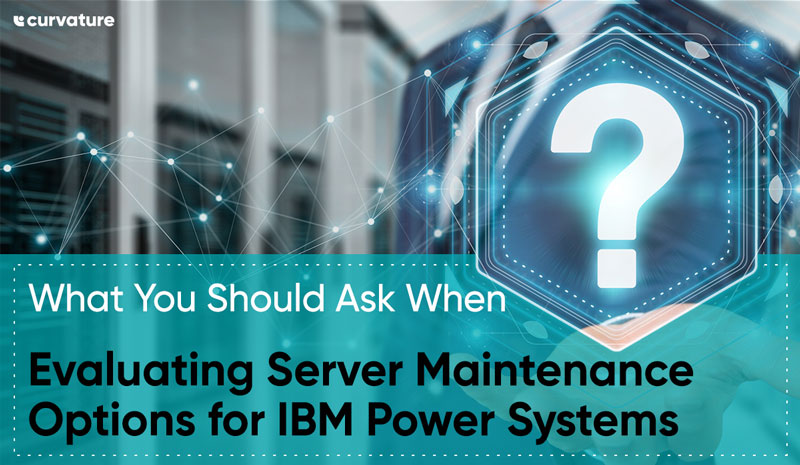In 2019, IBM sent businesses looking for a better plan for Power7 End of Service Life (EoSL) support. Further, they announced that IBM Power8 would stop being marketed and you can no longer order or get licensed upgrades. One option for businesses is to upgrade to IBM Power9 – whether they are needed or not. But the reality is that IBM Power8, Power7, and earlier generation server systems are highly reliable and still have years of useful asset life. I&O leaders looking to extend the lifecycle of these machines and reduce costs of server maintenance should look at all available IBM server maintenance options.
We’ve compiled a list of questions to ask server maintenance providers as you evaluate support options for IBM Power8 and earlier generation equipment:
1. Do you provide significant cost savings versus IBM’s maintenance rates for IBM Power Systems?
Check to ensure your maintenance costs are significantly lower than OEM support from IBM. This is often the single biggest reason companies move to a third-party server maintenance provider. Look to see if the independent Third-Party Maintenance (TPM) provider can provide at least 50% cost savings on IBM Power Server Maintenance.
Inquire about savings on both hardware maintenance and software/operating system maintenance. When hardware goes End of Life (EoL), there may be a savings opportunity on software maintenance as the operating system may also be EoL. This may lead to you dropping your software maintenance agreement or get some level of support but no longer pay the high cost to IBM for Operating System updates you may no longer need or use for AIX or OS/400. Look for this type of consultation and service from possible TPM providers.
2. Do you have a dedicated IBM Power Systems Lab for research and development?
The maintenance provider should have a dedicated IBM Power Series Lab for each of the server families for research and development and to gain expertise on the IBM hardware. This should include all servers supported by the TPM provider including Power8, Power7, Power6, Power5, Power4, and even the RS6000 and AS/400.
3. Are your engineers provided hands-on training in IBM Power Systems?
Speaking of labs, another great reason for maintenance providers to have one is so that engineers have hands-on training. Ask your provider how their maintenance engineers are trained and if they only have web-based training before you sign up for support on such an important part of your infrastructure.
4. Do you provide central engineering support (Level 3) in-house?
Be sure to ask if your server maintenance for your IBM Power8 and below servers have Level 3 support in-house from trained engineers. This infrastructure should not be trusted to remote hands or dial-a-tech type support.
5. Do you have a tested and secure remote monitoring system available for use on IBM Power?
Ensure the provider has remote monitoring abilities. The monitoring system should be tested and secure. Curvature’s Remote Enterprise Monitoring (REM) offering gives clients an equivalent level of monitoring and triage to what they received from the OEM for remote hardware monitoring.
6. Are your contract terms flexible?
Contract terms should provide you with the flexibility to tailor your service level agreements (SLAs) based on business criticality and for each of your locations. More importantly, you should be able to consolidate all of your maintenance onto one contract with multiple OEMs – bundling maintenance for other server brands such as IBM, Dell EMC, HPE, Lenovo, Cisco, Intel, and Sun/Oracle.
7. Are you able to extend the life of the IBM Power servers?
Manufacturers such as IBM often declare products EoSL and will stop supporting an older product. The manufacturers do this to get their customers to upgrade to the newest product available. However, and especially in the case of the IBM Power Systems, these products are highly reliable, and can continue to be supported by qualified and trained engineers at TPM providers. A TPM you select should be able to support IBM Power8 and all earlier generations, and demonstrate that they are still supporting Power7, Power6, Power5, Power4/RS6000, and AS/400 today. Businesses are still using these older models and the maintenance provider should successfully show they are able to substantially extend asset life for these businesses
8. Are both support and parts available globally?
The availability and access to parts are vitally important – particularly when maintaining IBM Power Systems that are considered EoSL. A maintenance provider will have enough parts on hand for your servers. Each of these parts should be tested prior to being shipped to client location. These parts should be of the same quality that IBM would use and should be available globally within 2 hours of a customer site and ideally delivered from wholly-owned parts depots at regional and local levels.
Work with a top performer: Curvature.
Curvature is recognized as the global top performer for independent TPM and support for servers within the data center. As the largest independent IBM hardware maintenance and support provider in the world, Curvature takes support and responsiveness to a whole new level. Curvature can answer each of the above questions with, “Yes.”
Let us know how we can help you with your IBM Power Systems Maintenance?



